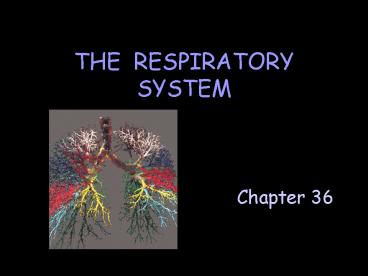THE RESPIRATORY SYSTEM - PowerPoint PPT Presentation
1 / 22
Title:
THE RESPIRATORY SYSTEM
Description:
External intercostal muscles. Exhalation (passive process) ... Medulla stimulates inspiratory muscles (diaphragm & external intercostal muscles) ... – PowerPoint PPT presentation
Number of Views:33
Avg rating:3.0/5.0
Title: THE RESPIRATORY SYSTEM
1
THE RESPIRATORY SYSTEM
- Chapter 36
2
- What is respiration?
- External respiration - exchange of O2 CO2
between respiratory surfaces the blood
breathing. - Internal respiration - exchange of O2 CO2
between the blood cells. - Cellular respiration - process by which cells use
O2 to produce ATP.
3
- A. Types of Respiratory Surfaces
- All respiratory surfaces MUST be
- moist
- thin
- large enough to meet metabolic needs of organism
- Challenges
- Aquatic organisms - H2O contains only 1/30 the O2
present in air. - Terrestrial organisms - must prevent desiccation
of respiratory surface.
4
- 1. Body surface
- simplest gas exchange mechanism
- adapted to moist environment
- may be associated with circulatory system
- protista
- cnidaria
- flatworms
- earthworms
- amphibians
5
- 2. Tracheae - highly branched system of internal
tubules. - adapted to terrestrial environment
- NOT associated with a circulatory system
- terrestrial arthropods
- Large, active arthropods use abdominal flight
muscles to ventilate tubules.
6
- 3. Gills - featherlike extensions of the body
surface. - adapted to aquatic environment
- may be external or internal
- some echinoderms
- some annelids
- aquatic mollusks
- crustaceans
- amphibian larvae some adult salamanders
- fish
7
- In fish
- operculum protects gills pumps water over their
surfaces - water flow is countercurrent to blood flow
8
- 4. Lungs - paired internal sacs lined with moist
epithelium. - adapted to terrestrial environment
- interact with circulatory system
- vertebrates
9
- B. Human Respiratory System
- 1. Nose
- lining is ciliated secretes mucus
- filters, warms moistens air
10
- 2. Pharynx Larynx
nasal cavity
- Pharynx (throat)
- muscular tube
- conducts air food
pharynx
larynx
- Larynx (Adams apple)
- cartilaginous structure
- contains vocal cords conducts air
What prevents food from entering
larynx? epiglottis What causes deepening of
male voice during puberty?
testosterone
11
- 3. Trachea, Bronchi Bronchioles
larynx
- Trachea (windpipe)
- tube supported by C-shaped cartilages
- lining is ciliated secretes mucus
trachea
bronchi
bronchioles
- Bronchi (sing. bronchus)
- pair of tubes that branch from trachea enter
lungs have cartilage plates - lining is ciliated secretes mucus
12
- Bronchioles
- tiny tubes lacking cartilage cilia
- possess smooth muscle
bronchiole
smooth muscle
- Autonomic nervous system regulates diameter of
bronchioles. - Sympathetic division dilates bronchioles
- Parasympathetic division constricts bronchioles
13
- 4. Alveoli (sing. alveolus)
- grape-like clusters of tiny, thin-walled sacs
- surrounded by capillaries
- sites of external respiration
- contain surfactant
- Surfactant keeps alveoli from collapsing.
14
- Path of air flow in external respiration
- nose ?
- pharynx ?
- larynx ?
- trachea ?
- bronchi ?
- bronchioles ?
- alveoli
15
- C. Breathing
- Occurs in response to pressure differences
between lungs atmosphere. - Inhalation (active process)
- diaphragm external intercostal muscles contract
- thoracic cavity volume ? air pressure ?
- air pulled inward lungs expand
External intercostal muscles
16
- Exhalation (passive process)
- diaphragm external intercostal (rib) muscles
relax lungs recoil - thoracic cavity volume ? air pressure ?
- air pushed outward lungs deflate
Forced exhalation is active - caused by
contraction of internal intercostal muscles
abdominal muscles. Can you force ALL air out of
your lungs?
17
- D. Gas Transport in Blood
- Carbon dioxide
- 70 as bicarbonate ion (HCO3-) dissolved in
plasma - 23 bound to hemoglobin
- 7 as CO2 dissolved in plasma
- Oxygen
- 99 bound to hemoglobin
- 1 as O2 dissolved in plasma
- Carbon monoxide poisoning occurs because CO binds
to hemoglobin more readily than O2.
18
Amount of O2 picked up by blood is affected by
altitude.
Amount of O2 released to tissues is affected by
requirements of cells.
19
- E. Control of Breathing
- Breathing is regulated by the rhythmicity center
in the medulla of brain.
rhytmicity center
Medulla stimulates inspiratory muscles (diaphragm
external intercostal muscles).
20
- The most important factor affecting the
rhythmicity center is CO2.
- ? in arterial CO2 causes ? in acidity of
cerebrospinal fluid (CSF). - ? in CSF acidity is detected by pH sensors in
medulla.
- medulla ? rate depth of breathing.
21
- Oxygen level does not regulate breathing unless
arterial O2 falls dangerously low.
22
- F. Respiratory System Disorders
- Asthma - muscles of bronchioles constrict,
drastically reducing ventilation. - Emphysema - destruction of alveoli.
- Tuberculosis - highly contagious bacterial
infection.
- Lung cancer - gt 90 of lung cancer victims have a
history of smoking.































